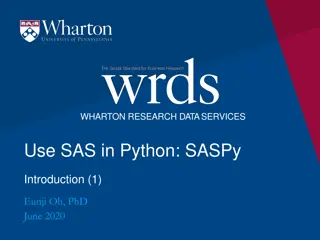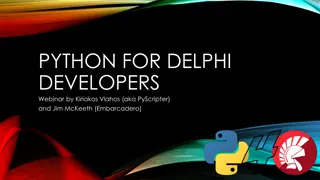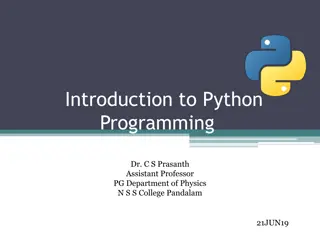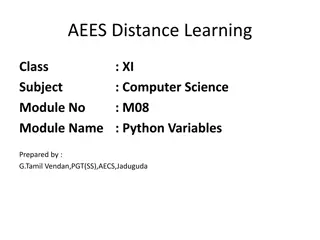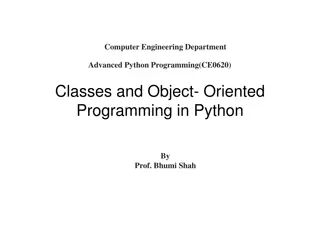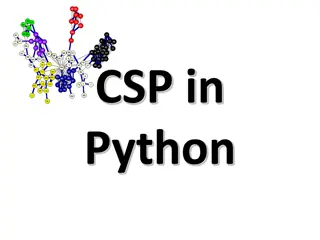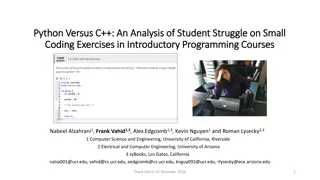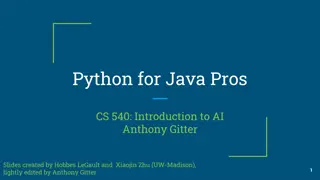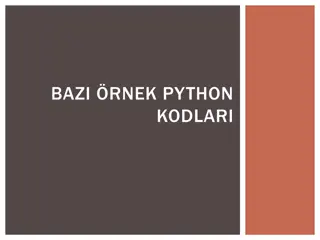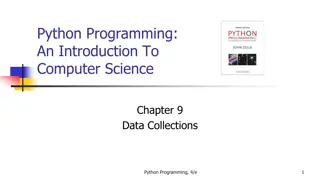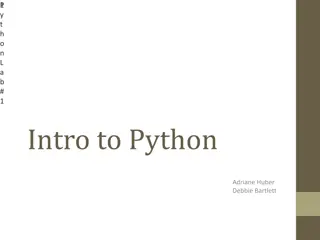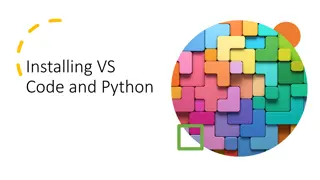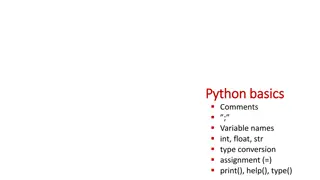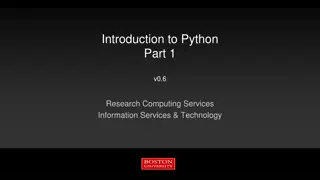
Python Programming Essentials and Tools for Success
Discover Python programming basics, essential tools like Anaconda and PyCharm, class fundamentals, data structures, and more. Get started on your Python journey with the right resources and guidance.
Download Presentation

Please find below an Image/Link to download the presentation.
The content on the website is provided AS IS for your information and personal use only. It may not be sold, licensed, or shared on other websites without obtaining consent from the author. If you encounter any issues during the download, it is possible that the publisher has removed the file from their server.
You are allowed to download the files provided on this website for personal or commercial use, subject to the condition that they are used lawfully. All files are the property of their respective owners.
The content on the website is provided AS IS for your information and personal use only. It may not be sold, licensed, or shared on other websites without obtaining consent from the author.
E N D
Presentation Transcript
CS229 Python & Numpy Jingbo Yang, Andrey Kurenkov
How is python related to with others? Python 2.0 released in 2000 (Python 2.7 end-of-life in 2020) Python 3.0 released in 2008 (Python 3.6 for CS 229) Can run interpreted, like MATLAB https://www.researchgate.net/figure/Genealogy-of-Programming-Languages-doi101371- journalpone0088941g001_fig1_260447599
Before you start Use Anaconda Create an environment (full Conda) conda create -n cs229 Create an environment (Miniconda) conda env create -f environment.yml Activate an environment conda activate cs229
Notepad is not your friend Get a text editor/IDE PyCharm (IDE) Visual Studio Code (IDE??) Sublime Text (IDE??) Notepad ++/gedit Vim (for Linux)
To make you more prepared PyCharm magic: FYI, professional version free for students: https://www.jetbrains.com/student/
Where does my program start? It just works A function Properly
What is a class? Initialize the class to get an instance using some parameters Instance variable Does something with the instance
To use a class Instantiate a class, get an instance Call an instance method
Basic data structures List example_list = [1, 2, '3', 'four ] Set (unordered, unique) example_set = set([1, 2, '3', 'four ]) Dictionary (mapping) example_dictionary = { '1': 'one', '2': 'two', '3': 'three' }
More on List 2D list list_of_list = [[1,2,3], [4,5,6], [7,8,9]] List comprehension initialize_a_list = [i for i in range(9)] initialize_a_list = [i ** 2 for i in range(9)] initialize_2d_list = [[i + j for i in range(5)] for j in range(9)] Insert/Pop my_list.insert(0, stuff) print(my_list.pop(0))
More on List Sort a list random_list = [3,12,5,6] sorted_list = sorted(random_list) random_list = [(3, A ),(12, D ),(5, M ),(6, B )] sorted_list = sorted(random_list, key=lambda x: x[1])
More on Dict/Set Comprehension my_dict = {i: i ** 2 for i in range(10)} my_set = {i ** 2 for i in range(10)} Get dictionary keys my_dict.keys()
What is Numpy? What is Scipy? Numpy package for vector and matrix manipulation Scipy package for scientific and technical computing How do those guys make things run faster? Read on AVX instruction set (SIMD) and structure of x86 and RISC Read on OpenMP and CUDA for multiprocessing Read on assembly-level optimization, memory stride, caching, etc. Or even about memory management, virtualization More bare metal FPGA, TPU
Popular usage, read before use! Python Command Description scipy.linalg.inv Inverse of matrix (numpy as equivalent) scipy.linalg.eig Get eigen value (Read documentation on eigh and numpy equivalent) scipy.spatial.distance Compute pairwise distance np.matmul Matrix multiply np.zeros Create a matrix filled with zeros (Read on np.ones) np.arange Start, stop, step size (Read on np.linspace) np.identity Create an identity matrix np.vstack Vertically stack 2 arrays (Read on np.hstack)
Your friend for debugging Python Command Description array.shape Get shape of numpy array array.dtype Check data type of array (for precision, for weird behavior) type(stuff) Get type of a variable import pdb; pdb.set_trace() Set a breakpoint (https://docs.python.org/3/library/pdb.html) print(f My name is {name} ) Easy way to construct a message
So many things to remember Why can t I just write loops? Remember all the fancy low-level stuff?
Power of vectorization a = [i for i in range(10000)]; b = [i for i in range(10000)]; tic = time.clock() dot = 0.0; for i in range(len(a)): dot += a[i] * b[i] toc = time.clock() print("dot_product = "+ str(dot)); print("Computation time = " + str(1000*(toc - tic )) + "ms") n_tic = time.clock() n_dot_product = np.array(a).dot(np.array(b)) n_toc = time.clock() print("\nn_dot_product = "+str(n_dot_product)) print("Computation time = "+str(1000*(n_toc - n_tic ))+"ms")
Matplotlib is your friend Scatter plot Line plot Duo y-axis Log-log Bar plot (Histogram) 3D plot Jupyter Notebook is another friend And if you want to get fancy:
Example plots https://matplotlib.org/3.1.1/gallery/index.html import matplotlib import matplotlib.pyplot as plt import numpy as np Import # Data for plotting t = np.arange(0.0, 2.0, 0.01) s = 1 + np.sin(2 * np.pi * t) Create data fig, ax = plt.subplots() ax.plot(t, s) Plotting ax.set(xlabel='time (s)', ylabel='voltage (mV)', title='About as simple as it gets, folks') ax.grid() Format plot fig.savefig("test.png") plt.show() Save/show
Plot with dash lines and legend https://matplotlib.org/3.1.1/gallery/index.html import numpy as np import matplotlib.pyplot as plt x = np.linspace(0, 10, 500) y = np.sin(x) fig, ax = plt.subplots() line1, = ax.plot(x, y, label='Using set_dashes()') line1.set_dashes([2, 2, 10, 2]) # 2pt line, 2pt break, 10pt line, 2pt break line2, = ax.plot(x, y - 0.2, dashes=[6, 2], label='Using the dashes parameter') ax.legend() plt.show()
Confusion matrix https://scikit-learn.org/stable/auto_examples/model_selection/plot_confusion_matrix.html fig, ax = plt.subplots() im = ax.imshow(cm, interpolation='nearest', cmap=cmap) ax.figure.colorbar(im, ax=ax) # We want to show all ticks... ax.set(xticks=np.arange(cm.shape[1]), yticks=np.arange(cm.shape[0]), xticklabels=classes, yticklabels=classes, title=title, ylabel='True label', xlabel='Predicted label') # Rotate the tick labels and set their alignment. plt.setp(ax.get_xticklabels(), rotation=45, ha="right", rotation_mode="anchor") # Loop over data dimensions and create text annotations. fmt = '.2f' if normalize else 'd' thresh = cm.max() / 2. for i in range(cm.shape[0]): for j in range(cm.shape[1]): ax.text(j, i, format(cm[i, j], fmt), ha="center", va="center", color="white" if cm[i, j] > thresh else "black") fig.tight_layout()
What is Numpy? What is Scipy? Numpy package for vector and matrix manipulation Scipy package for scientific and technical computing How do those guys make things run faster? Read on AVX instruction set (SIMD) and structure of x86 and RISC Read on OpenMP and CUDA for multiprocessing Read on assembly-level optimization, memory stride, caching, etc. Or even about memory management, virtualization More bare metal FPGA, TPU
Power of vectorization a = [i for i in range(10000)]; b = [i for i in range(10000)]; tic = time.clock() dot = 0.0; for i in range(len(a)): dot += a[i] * b[i] toc = time.clock() print("dot_product = "+ str(dot)); print("Computation time = " + str(1000*(toc - tic )) + "ms") n_tic = time.clock() n_dot_product = np.array(a).dot(np.array(b)) n_toc = time.clock() print("\nn_dot_product = "+str(n_dot_product)) print("Computation time = "+str(1000*(n_toc - n_tic ))+"ms")
Popular usage, read before use! Python Command Description scipy.linalg.inv Inverse of matrix (numpy as equivalent) scipy.linalg.eig Get eigen value (Read documentation on eigh and numpy equivalent) scipy.spatial.distance Compute pairwise distance np.matmul Matrix multiply np.zeros Create a matrix filled with zeros (Read on np.ones) np.arange Start, stop, step size (Read on np.linspace) np.identity Create an identity matrix np.vstack Vertically stack 2 arrays (Read on np.hstack)
Your friend for debugging Python Command Description array.shape Get shape of numpy array array.dtype Check data type of array (for precision, for weird behavior) type(stuff) Get type of a variable import pdb; pdb.set_trace() Set a breakpoint (https://docs.python.org/3/library/pdb.html) print(f My name is {name} ) Easy way to construct a message
Links CS 231N Python Tutorial
Good luck on your HW/Project! Questions?



